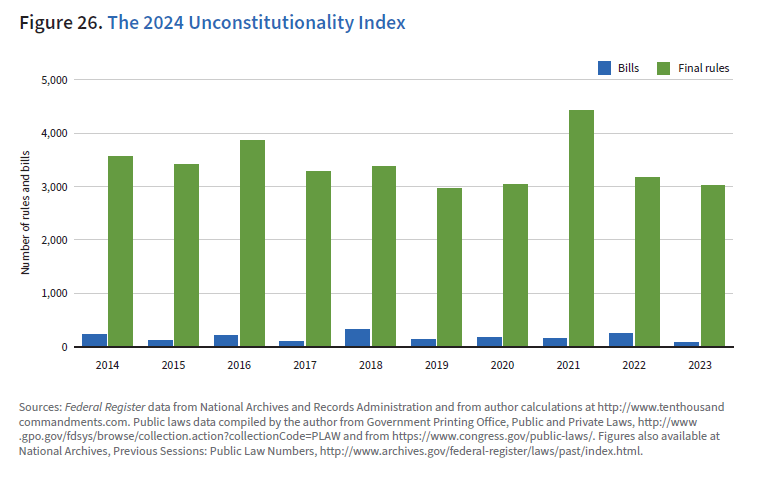Chapter 12: The 2024 Unconstitutionality Index: 44 rules for every law
Article I of the Constitution notwithstanding, administrative agencies rather than Congress do most of the lawmaking in the United States. Congress enacts weighty legislation but then delegates substantial lawmaking power to agencies to flesh out details that can exceed intended bounds. From an agency’s perspective, the primary measure of its productivity is the body of regulation it produces, so Congress’s willingness to delegate is welcomed and adds to the incentives for expansion.
This imbalance gives rise to the Unconstitutionality Index, the ratio of rules issued by agencies relative to laws passed by Congress and signed by the president during a calendar year. During 2023, federal regulatory agencies issued 3,018 final rules, compared with Congress’s passing 68 bills (34 each from the outgoing 117th Congress during January 2023, and the 118th Congress since then). That means 44 rules were issued for every law passed in 2023. The ratio obviously can and does easily fluctuate with changes in the numerator or denominator; however, 44 is uncharacteristically high for the Index owing to the unusually small number of laws passed (see Figure 26 for the 2024 Unconstitutionality Index). The average over the past decade has been 23 rules issued by federal agencies for every law passed by Congress.
Federal agency rules in any given year are not likely to be associated with laws passed that same year; for example, regulations coming to the fore now are and will be the fruit of legislation like the inflation and infrastructure laws passed in recent years. Appendix M provides a look-back over the past three decades of rules and laws, and also depicts executive orders and memoranda for comparison and that may for some purposes be incorporated into a future Index.

